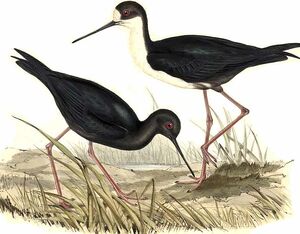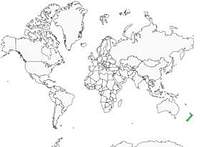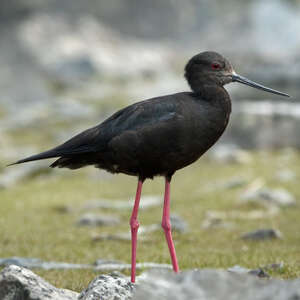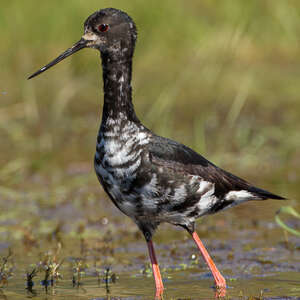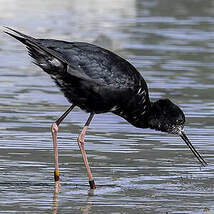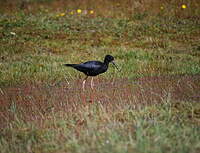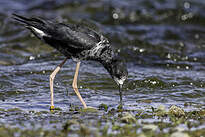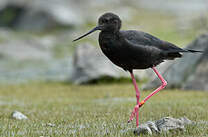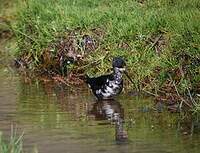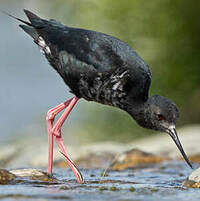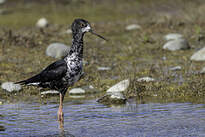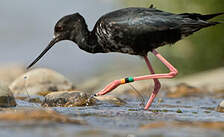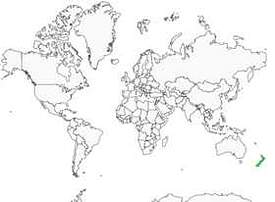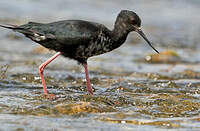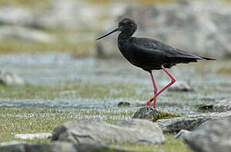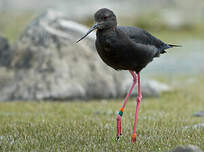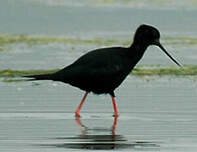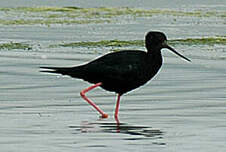Black Stilt
Himantopus novaezelandiae - Échasse noire
Identification
Simply put, it's a Black Stilt. A bird that truly lives up to its name! A long, thin, black beak and long red legs complete the picture... at least at first glance... since one can sometimes encounter hybrids of this species with the Australian Stilt (Himantopus leucocephalus) and one has to look very closely to detect some white on certain birds seen from afar. Compared to its Australian relative (which is common in New Zealand), the Black Stilt has the longer beak and shorter legs. Males and females are identical in appearance. Juveniles and immatures are more easily distinguished from leucocephalus. Juveniles have a black back, belly and undertail, the rest of the body is white, except for a black mask above and behind the eye. Immatures are almost entirely black but one can see a few white feathers here and there on the body, especially in front. Hybrids either have a black necklace or the front of the body is black.
Subspecific information monotypic species
Foreign names
- Échasse noire,
- Cigüeñuela negra,
- pernilongo-preto,
- Rußstelzenläufer,
- fekete gólyatöcs,
- Zwarte Steltkluut,
- Cavaliere nero,
- svart styltlöpare,
- Svartstylteløper,
- šišila smútočná,
- pisila černá,
- Sort Stylteløber,
- mustapitkäjalka,
- camallarga negre,
- szczudłak czarny,
- Новозеландский ходулочник,
- クロセイタカシギ,
- 黑长脚鹬,
- svart styltlöpare,
- 黑高蹺鴴,
Voice song and call
Habitat
The Black Stilt is endemic to New Zealand where it breeds at the banks of some rivers and lakes in the center of the South Island. It also frequents marshes. In winter, it moves little, unlike the Australian Stilt. Black individuals have sometimes been observed in the North Island during this season, but it seems likely that they are hybrids between the two species.
Behaviour character trait
As we have just seen, most families stay near the breeding sites in the winter, not straying further than the nearest lake deltas.
Thus they are on their breeding grounds long before the individuals of the other species arrive. Black Stilt, or the true ones at least, don't willingly mix with the black and white kind, which are true migrators. This de facto separation has enabled it to remain as a species, when we feared that hybridization would eventually make it disappear. It isn't an excessively timid species.Dietfeeding habits
Reproduction nesting
The Black Stilt's breeding season extends from September to January. Unlike H. leucocephalus, it is not a colonial species and couples do not nest close to each other (which increases predation risks, as colonial birds more efficiently defend eggs and young against predators, considering that this species doesn't have a highly developed anti-predation behavior, and sometimes does not seem to be worried about it!) The clutch size is of 4 eggs and there may be a replacement laying.
The nest is usually located near water, which makes it vulnerable to floods. The young are nidifugous.Threats - protection
IUCN conservation status
concern
in the Wild
threatened
evaluated
This is the most threatened wader in the world and I must admit that the sight of this bird was something special for me... BirdLife International has classified it as "critically endangered". By the end of the twentieth century, there were only about forty individuals in the wild, with barely nine females. New Zealanders have created a breeding center that also houses about forty individuals.
In the 1940s, the population of the Black Stilt was estimated to be between 500 and 1 000 individuals; so it has lost 90% of its numbers in 50 years. Will it be able to survive? That is not certain!
The main causes of the decline are predation by introduced mammals (ferret, stoats, mice) but also by some native birds such as the Gould's Buzzard (Circus approximans) which is common and the Dominican Gull (Larus dominicanus) whose populations are expanding. The alteration of water courses and water sports also contribute to this drastic decrease. The low number of females is also very detrimental to the survival of the species.
Sources of information
- IOC World Bird List (v15.1), Gill, F and D Donsker (Eds). 2025-12-07.
Other sources of interest
 Specification sheet created on
01/08/2023 by Georges Olioso
Specification sheet created on
01/08/2023 by Georges OliosoTranslation by AI Oiseaux.net
© 1996-2025 Oiseaux.net
- Accipitriformes
- Aegotheliformes
- Anseriformes
- Apodiformes
- Apterygiformes
- Bucerotiformes
- Caprimulgiformes
- Cariamiformes
- Casuariiformes
- Charadriiformes
- Ciconiiformes
- Coliiformes
- Columbiformes
- Coraciiformes
- Cuculiformes
- Eurypygiformes
- Falconiformes
- Galliformes
- Gaviiformes
- Gruiformes
- Leptosomiformes
- Mesitornithiformes
- Musophagiformes
- Nyctibiiformes
- Opisthocomiformes
- Otidiformes
- Passeriformes
- Pelecaniformes
- Phaethontiformes
- Phoenicopteriformes
- Piciformes
- Podargiformes
- Podicipediformes
- Procellariiformes
- Psittaciformes
- Pterocliformes
- Rheiformes
- Sphenisciformes
- Steatornithiformes
- Strigiformes
- Struthioniformes
- Suliformes
- Tinamiformes
- Trogoniformes

